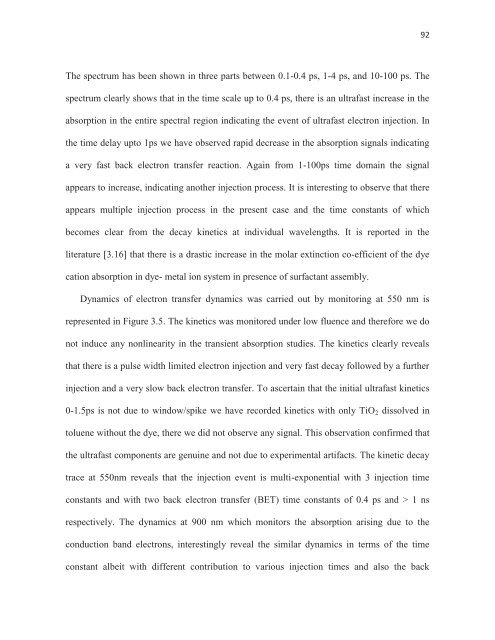CHEM01200604009 Sreejith Kaniyankandy - Homi Bhabha ...
CHEM01200604009 Sreejith Kaniyankandy - Homi Bhabha ...
CHEM01200604009 Sreejith Kaniyankandy - Homi Bhabha ...
You also want an ePaper? Increase the reach of your titles
YUMPU automatically turns print PDFs into web optimized ePapers that Google loves.
92<br />
The spectrum has been shown in three parts between 0.1-0.4 ps, 1-4 ps, and 10-100 ps. The<br />
spectrum clearly shows that in the time scale up to 0.4 ps, there is an ultrafast increase in the<br />
absorption in the entire spectral region indicating the event of ultrafast electron injection. In<br />
the time delay upto 1ps we have observed rapid decrease in the absorption signals indicating<br />
a very fast back electron transfer reaction. Again from 1-100ps time domain the signal<br />
appears to increase, indicating another injection process. It is interesting to observe that there<br />
appears multiple injection process in the present case and the time constants of which<br />
becomes clear from the decay kinetics at individual wavelengths. It is reported in the<br />
literature [3.16] that there is a drastic increase in the molar extinction co-efficient of the dye<br />
cation absorption in dye- metal ion system in presence of surfactant assembly.<br />
Dynamics of electron transfer dynamics was carried out by monitoring at 550 nm is<br />
represented in Figure 3.5. The kinetics was monitored under low fluence and therefore we do<br />
not induce any nonlinearity in the transient absorption studies. The kinetics clearly reveals<br />
that there is a pulse width limited electron injection and very fast decay followed by a further<br />
injection and a very slow back electron transfer. To ascertain that the initial ultrafast kinetics<br />
0-1.5ps is not due to window/spike we have recorded kinetics with only TiO 2 dissolved in<br />
toluene without the dye, there we did not observe any signal. This observation confirmed that<br />
the ultrafast components are genuine and not due to experimental artifacts. The kinetic decay<br />
trace at 550nm reveals that the injection event is multi-exponential with 3 injection time<br />
constants and with two back electron transfer (BET) time constants of 0.4 ps and > 1 ns<br />
respectively. The dynamics at 900 nm which monitors the absorption arising due to the<br />
conduction band electrons, interestingly reveal the similar dynamics in terms of the time<br />
constant albeit with different contribution to various injection times and also the back
















